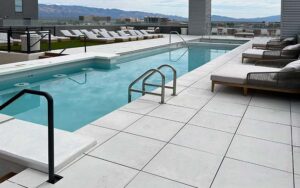When deciding between porcelain and concrete pavers, the choice is more than just a matter of aesthetics — it’s about finding the right material that balances durability, style and maintenance for your outdoor project. Each offers distinct benefits depending on the design needs and environment.
Overview of Paver Types
Concrete pavers are made with cement, water, aggregates and sometimes additional additives. They can bear heavy loads and withstand various weather conditions — which is why concrete is often a go-to material for walkways, roads and patios.
Porcelain pavers combine special clays and specific additives that are kiln-fired to 1,200 to 1,400 degrees Fahrenheit. This process creates a material resistant to moisture absorption and damage from foot traffic and the elements, making porcelain pavers highly suited for outdoor applications.
Porcelain Pavers vs. Concrete Pavers
Both porcelain and concrete have pros and cons as materials for pavers. Here are a few areas in which they can differ.
Aesthetic and Design Considerations
While some people think porcelain has a distinct aesthetic, it can actually come in various visual styles to enhance landscapes with richer colors and detail-oriented designs. Porcelain pavers can also mimic the appearance of materials like wood, slate, natural stone or concrete with smooth and textured options, providing increased design flexibility.
Looking at concrete, it typically has a rougher texture than porcelain and has a grayish color that can be dyed with pigments to create different tones. Concrete is also comparatively easy to sculpt into different shapes, including finely detailed patterns.
Performance and Durability
The firing process of porcelain makes it exceptionally durable. It can withstand extremely heavy loads and is resistant to cracks from changing outdoor temperatures, making it an excellent material for pavers.
Porcelain is also highly scratch-resistant, so grit from footwear and the movement of outdoor furniture is unlikely to leave marks.
Although concrete is also known for being tough and load-bearing, it can be vulnerable to wear and tear. Because of its porosity, it tends to absorb water, leading to cracks in cold environments where water freezes and thaws.
Maintenance and Installation
When it comes to maintaining porcelain tiles, the process is easy — its non-porous surface naturally resists stains without any sealing requirements. If something does spill on porcelain, a quick cleaning with water or a diluted detergent should do the trick.
However, while porcelain’s tough characteristics are ideal for standing against Mother Nature and everyday use, its denseness can make it more difficult to cut or drill. In addition, because they are thinner than concrete pavers, porcelain pavers require different site preparation for on-grade installation.
Thankfully, many experienced professionals offer installation services to alleviate these potential pain points.
On the other hand, while concrete pavers are slightly easier to install, maintaining them is much more difficult compared to porcelain pavers. The porous nature of concrete pavers makes them more vulnerable to stains and cracks, so they should be sealed every three to five years.
Cost and Value Considerations
Porcelain is typically more expensive to buy than concrete, and installation can cost extra if contracted out. However, the ease of maintenance and lower likelihood of replacement or repair means that porcelain pavers can be a better long-term investment.
Conversely, concrete pavers are cheaper than porcelain but are more likely to require costly maintenance, repair or replacement. This is because they are more vulnerable than porcelain to cracks, stains and damage.
Environmental and Sustainability Factors
Porcelain is made from natural materials, making it a more sustainable option compared to concrete. In addition, high-quality porcelain pavers can be removed, recycled and reused, contributing to their sustainability.
Cement — a key component of concrete — production is believed to account for 8% of global carbon emissions. This makes concrete one of the least environmentally friendly materials out there. The ability to recycle concrete also depends on individual recycling centers’ capabilities.
Applications and Suitability
Porcelain pavers’ durability and aesthetic diversity make them suitable for many different outdoor spaces. Here are just a few applications where porcelain pavers would excel:
- Poolside Retreats: The fact that many porcelain pavers are available with textured surfaces also gives them slip-resistant properties, making them useful for poolside spaces.
- Outdoor Kitchens and Bars: Because of their stain resistance, porcelain pavers are safe to use where spills are bound to happen. Porcelain’s impermeability also allows it to resist mold and mildew, making it an even better choice for these types of areas.
- Driveways: As a testament to their durability, certain porcelain pavers can endure both foot and vehicular traffic, making them ideal for driveway applications.
- Rooftops: When paired with Achatrak’s non-combustible ’Incendio’ pedestals, porcelain pavers are Class A fire-rated, provide adequate drainage and can hide cables and wires for aesthetic and safety purposes, making them highly beneficial for rooftop projects.
When it comes to concrete, it is a popular choice for areas like roads and sidewalks due to its high load-bearing capabilities.
However, unlike porcelain pavers, concrete’s porosity and regular maintenance needs make it unsuitable for certain applications and environments, such as climates with frequent freeze-thaw cycles or areas where staining is an issue.
Find The Perfect Pavers With Archatrak
At Archatrak, we have supplied customers with top-quality exterior porcelain pavers for over two decades. Whether your project is a simple on-grade garden patio or a commercial rooftop terrace, we can help you find the right pavers to bring your vision to life.
Our porcelain pavers are available in various colors, sizes and styles, including wood, stone and cement. We also offer products with plenty of installation options, from placing pavers directly onto the ground to using adjustable height paver supports.
Contact our expert team to learn more about our pavers and how you can secure them for your next project.
—



